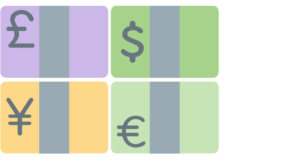Volatility rose during April. The Trump administration’s new tariff announcements led to much higher trade uncertainty.
At the start of the month, a range of tariffs were announced on the USA’s major trading partners. Not all of the USA’s trading partners were treated equally, though. China and Vietnam particularly faced much higher tariffs than those announced for countries such as Australia. Trade tensions then continued to escalate between China and the USA, with tariffs between the 2 countries at over 100% by the end of the month.
There was a lot of volatility in share markets in the days immediately after the announcement of the USA’s tariffs. However, these markets recovered through April, after a 90 day pause on reciprocal tariffs for countries which had not retaliated to the USA. The MSCI World (hedged into AUD) returned -0.4% over the month.

USA
Volatility was most pronounced in the US equity market (-0.7% for the S&P 500), compared to other nations’ equity markets. This comparatively good overall return for the month doesn’t reflect the true level of instability seen through the month (there was a point when the US market was down as much as 10%).
The US Federal Reserve kept interest rates at 4.5%. They referred to the rising uncertainty in the economic outlook as the reason they kept interest rates unchanged. They also noted that inflation and unemployment had risen in April.

Europe
European equities were also weaker, likely as a consequence of the USA’s trade policy. Business activity indicators in the Eurozone have generally been weaker over the month; across both services and manufacturing.

Asia
Chinese and Taiwanese equity markets were weak in April. Concerns about the USA tariffs were a key factor to this poor performance. There was great concern that trade between China and the USA would drop sharply and that this would impact China’s export heavy economy. After the end of April, a 90-day pause was announced in tariffs between China and the USA. This resulted in the USA tariffs on Chinese imports being closer to 30%.

Australia
Australian equities finished the month stronger (3.6% for April). It outperformed Developed Market equities. All sectors (except Energy) provided positive returns for the month. Real estate investment trusts and Information Technology were particularly strong. Consumer sentiment fell 6% in April, but has since partially come back (by 2.2% in May). Surveys of business activity also remained relatively subdued.

Currency and bonds
Australian bond returns were quite strong, returning 1.7% for April. Global bond returns were also positive, returning 0.9%. Global bonds were initially weaker following the announcement of tariffs in early April, but recovered over the course of the month. The Australian 10 year yield finished the month at 4.12%.
Most major currencies were stronger relative to the US Dollar. The Australian dollar was also stronger relative to the USD over the month, returning 2.7%. However, the Australian dollar was weaker relative to the currencies of most major trading partners over April.

